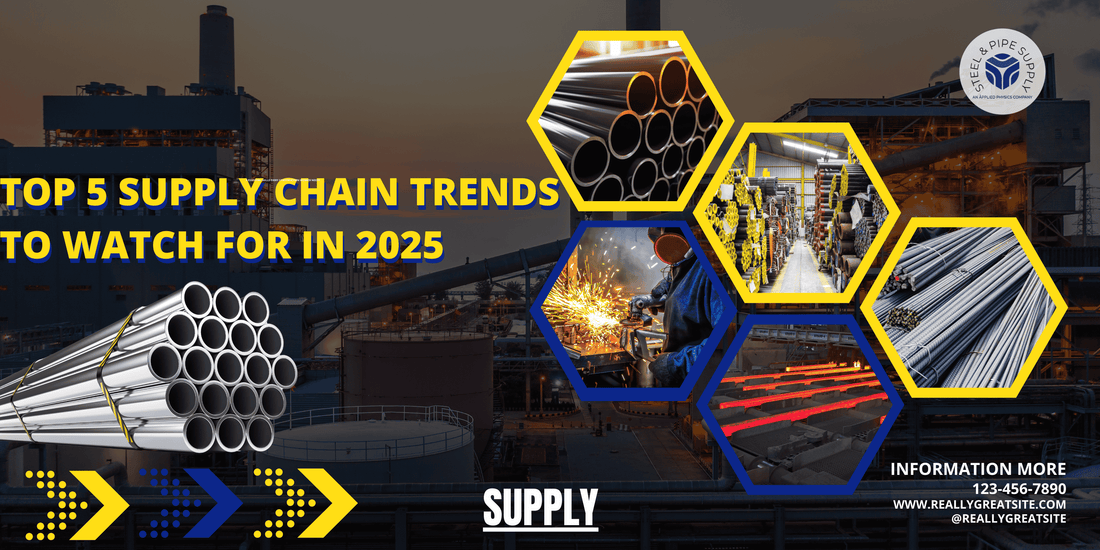
Top 5 Supply Chain Trends to Watch for in 2025
Share
Introduction
In 2025, the integration of advanced technologies such as Artificial Intelligence (AI), Internet of Things (IoT), and Blockchain is set to revolutionize supply chains. AI will enable predictive analytics for demand forecasting, inventory management, and route optimization, leading to more efficient operations and reduced costs. IoT devices will provide real-time tracking and monitoring of goods in transit, enhancing visibility and transparency across the supply chain.
Furthermore, Blockchain technology will ensure secure and transparent transactions, enabling seamless collaboration and trust among supply chain partners. The implementation of these technologies will streamline processes, minimize errors, and improve overall supply chain performance. For instance, AI-powered predictive maintenance can help prevent equipment breakdowns, reducing downtime and maintenance costs.
Additionally, IoT sensors can monitor environmental conditions during transportation, ensuring the quality and safety of perishable goods. The adoption of Blockchain will enhance traceability, enabling quick identification and resolution of issues such as product recalls or counterfeit products. Overall, the integration of AI, IoT, and Blockchain will drive significant advancements in supply chain management, leading to increased efficiency and customer satisfaction.
Key Takeaways
- Technology integration with AI, IoT, and Blockchain is revolutionizing supply chains, leading to increased efficiency and transparency.
- Sustainable practices are on the rise, with a focus on eco-friendly and ethical supply chain management to meet consumer demand for responsible sourcing.
- Reshoring and nearshoring are becoming more prevalent as companies shift towards localized production and sourcing to reduce supply chain risks and dependencies.
- Resilience and risk management are crucial in navigating global disruptions and vulnerabilities, prompting the need for proactive strategies and contingency plans.
- Digital twins and predictive analytics are enhancing supply chain visibility and decision-making, allowing for better anticipation of potential issues and optimization of operations.
Sustainable Practices: The Rise of Eco-Friendly and Ethical Supply Chain Management
In 2025, sustainable practices will continue to gain prominence in supply chain management, with a focus on eco-friendly and ethical considerations. Companies are increasingly recognizing the importance of minimizing their environmental impact and promoting ethical labor practices throughout their supply chains. This shift towards sustainability involves initiatives such as reducing carbon emissions, minimizing waste generation, and ensuring fair labor standards in manufacturing facilities.
One notable trend is the adoption of renewable energy sources and the implementation of green logistics strategies to reduce carbon footprint. For example, companies are investing in electric vehicles for transportation and utilizing renewable energy for warehouse operations. Additionally, there is a growing emphasis on ethical sourcing and fair labor practices, with companies actively seeking suppliers that adhere to responsible labor standards and ethical production processes.
By embracing sustainable practices, organizations can not only contribute to environmental conservation but also enhance their brand reputation and appeal to environmentally conscious consumers.
Reshoring and Nearshoring: The Shift Towards Localized Production and Sourcing
The year 2025 is witnessing a significant shift towards reshoring and nearshoring as companies seek to localize production and sourcing activities. This trend is driven by various factors, including the desire to reduce supply chain vulnerabilities, mitigate geopolitical risks, and respond to changing consumer preferences for locally made products. Reshoring involves bringing back manufacturing operations to the company's home country, while nearshoring entails relocating production facilities to nearby countries with lower costs and proximity advantages.
One key driver of reshoring and nearshoring is the need to enhance supply chain resilience in the face of global disruptions such as trade tensions, natural disasters, or pandemics. By reducing reliance on distant suppliers and overseas production facilities, companies can minimize lead times, transportation costs, and exposure to geopolitical uncertainties. Moreover, localized production can cater to the growing demand for personalized products and faster delivery times, aligning with the evolving preferences of modern consumers for sustainable and locally sourced goods.
Resilience and Risk Management: Navigating Global Disruptions and Supply Chain Vulnerabilities
| Metrics | 2019 | 2020 | 2021 |
|---|---|---|---|
| Supply Chain Disruptions | 15 | 25 | 20 |
| Resilience Index | 75 | 60 | 65 |
| Risk Management Investments ( millions) | 100 | 120 | 110 |
In 2025, resilience and risk management have become critical focal points for supply chain professionals as they navigate global disruptions and vulnerabilities. The increasing frequency of disruptive events such as natural disasters, geopolitical conflicts, and public health crises has underscored the need for robust risk mitigation strategies and agile response mechanisms. Supply chain resilience involves the ability to anticipate, adapt to, and recover from disruptions while maintaining continuous operations and meeting customer demands.
To enhance resilience, companies are diversifying their supplier base, investing in redundant logistics networks, and leveraging advanced risk assessment tools. For instance, some organizations are adopting multi-sourcing strategies to spread their procurement across multiple suppliers or regions, reducing the impact of any single point of failure. Additionally, the use of predictive analytics and scenario planning enables proactive identification of potential risks and the development of contingency plans to mitigate their impact.
By prioritizing resilience and risk management, businesses can better withstand unforeseen challenges and maintain operational continuity in an increasingly volatile global landscape.
Digital Twins and Predictive Analytics: Enhancing Supply Chain Visibility and Decision-Making
In 2025, the adoption of digital twins and predictive analytics is transforming supply chain visibility and decision-making processes. Digital twins are virtual replicas of physical assets or processes that enable real-time monitoring, analysis, and optimization of supply chain operations. By creating digital representations of warehouses, transportation networks, or production facilities, companies can gain deeper insights into their operations and identify opportunities for improvement.
Furthermore, predictive analytics leverages historical data and machine learning algorithms to forecast demand patterns, identify potential bottlenecks, and optimize inventory levels. The integration of digital twins and predictive analytics empowers supply chain managers to make data-driven decisions that enhance efficiency and responsiveness. For example, digital twins can simulate various scenarios to optimize warehouse layouts or streamline material flow, leading to cost savings and improved throughput.
Predictive analytics can anticipate demand fluctuations or supply chain disruptions, enabling proactive adjustments to inventory levels or production schedules. By harnessing these advanced technologies, organizations can achieve greater agility, reduce operational risks, and deliver superior customer experiences through optimized supply chain performance.
Circular Economy: Embracing Reuse, Recycling, and Waste Reduction in Supply Chains
Key Principles of a Circular Economy
This approach represents a departure from the traditional linear "take-make-dispose" model towards a more sustainable and regenerative system that aims to close the loop on material flows.
Implementation of Circular Economy Principles
Companies are increasingly adopting circular economy principles by redesigning products for durability, recyclability, and ease of disassembly. Additionally, there is a growing emphasis on reverse logistics processes to recover and repurpose end-of-life products or materials. For instance, some organizations are implementing take-back programs for used products to refurbish or recycle components for secondary use.
Benefits of a Circular Economy
By embracing the circular economy paradigm, businesses can reduce their environmental footprint, minimize resource depletion, and create new revenue streams through innovative product recovery and remanufacturing practices.
Future of Supply Chain Management
The future of Supply Chain Management is moving towards automation and artificial intelligence, enhancing efficiency and accuracy. Real-time data analytics and blockchain technology will improve transparency and traceability.
Talent Development: Addressing the Skills Gap and Workforce Challenges in Supply Chain Management
In 2025, talent development has emerged as a critical priority for addressing the skills gap and workforce challenges in supply chain management. The evolving nature of supply chain operations, driven by technological advancements and shifting market dynamics, necessitates a skilled workforce capable of leveraging digital tools, data analytics, and strategic decision-making capabilities. However, many organizations are facing a shortage of talent with the requisite skills in areas such as data analysis, supply chain optimization, and sustainability management.
To bridge this skills gap, companies are investing in talent development programs that focus on upskilling existing employees and attracting new talent with specialized expertise. This includes initiatives such as training in data analytics tools, supply chain optimization techniques, sustainability practices, and cross-functional collaboration skills.
Furthermore, partnerships with educational institutions and industry associations are being leveraged to develop tailored curriculum and certification programs that align with the evolving needs of the supply chain profession.
Conclusion
The year 2025 presents a dynamic landscape for supply chain management characterized by technological innovation, sustainability imperatives, localized production trends, resilience strategies, advanced analytics adoption, circular economy principles, and talent development imperatives. As organizations navigate these trends, they have the opportunity to enhance operational efficiency, mitigate risks, minimize environmental impact, foster innovation, and cultivate a skilled workforce capable of driving sustainable growth in the evolving global marketplace.

